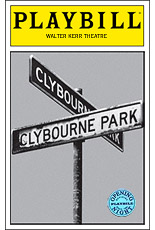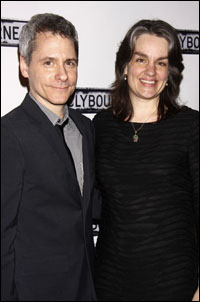
*
Like they say: Location! Location! Location! It has taken two years and two months for Clybourne Park to move eight blocks uptown from Off-Broadway's Playwrights Horizons to Broadway's Walter Kerr Theatre, where it arrived April 19, and even then it required the push and prestige of a Pulitzer Prize to get there.
It landed rather unsteadily, with one of its major backers loudly backing out in the homestretch, requiring a lot of financial scrambling-about to secure its place on The Great White Way. Jujamcyn Theaters' young sun god, Jordan Roth, stepped up to the plate, and a raft of Roth co-producers helped him shore up the property.
"From the moment I read it, I was captivated," admitted Roth helplessly. "The play pulls people to it. It compels people to be a part of it, to amplify it, to surround it."
A half-century separates the two acts of Clybourne Park, which gets its name from a middle-class white 'burb in Chicago. In 1959, a white family is moving out, and a black family is moving in; in 2009, that color scheme is reversed. Much racial sturm und drang accompany both attempts to move upward to a better life. The original African-Americans who "block-busted" their way into Clybourne Park are not seen in the play — this play. They are the Youngers, who resided in Lorraine Hansberry's classic, A Raisin in the Sun; the lone Caucasian to intrude on their world was an unctuous little man named Lindner, who, representing the neighborhood "improvement association," tried unsuccessfully to buy the house back from the Youngers. John Fiedler played the conniving pipsqueak in the original drama, in its movie version and in one of the play's last Off-Broadway revivals. In Clybourne Park, the character is played by a buttoned-down and no-less-determined Jeremy Shamos, fresh from the Youngers' rejection and threatening the white owners with legal action from their "friends" and neighbors.
[flipbook] Bruce Norris, who let his imagination drift from A Raisin in the Sun into Clybourne Park, was an actor before he was a playwright but said he never auditioned for Lindner. "However," he asterisked, "one of my best friends was best friends with John Fiedler." (Lindner was one of Fiedler's three best-remembered roles: he was Juror #2, the least angry of the "12 Angry Men," and the high-pitched voice for Piglet in Disney's animated "Winnie the Pooh" productions.)
The next Norris on the horizon, written for Lincoln Center, is currently titled Domesticated and is set to surface there in the fall of 2013, he said.
Lincoln Center Theater was one of the organizations that came up with the emergency funding needed to bring Clybourne Park to Broadway. Another was Playwrights Horizons, where the play world-premiered in February 2010.
That makes five Pulitzer Prize plays that originated at Playwrights Horizons, its artistic director was happy to point out. It follows Doug Wright's also Tony-winning I Am My Own Wife, Wendy Wasserstein's The Heidi Chronicles, Alfred Uhry's Driving Miss Daisy and Stephen Sondheim and James Lapine's Sunday in the Park with George.
"At our spring benefit," said Tim Sanford, "we're honoring all five of our Pulitzer Prize winners, and all of the authors — except Wendy, of course — will be there." The gala, slugged "The Highest Standard," is set for Monday, June 11, at the event space 583 Park Avenue. Songs, excerpts and testimonials are the bill of fare.

Buy this Limited Collector's Edition |
All of the above were thunderous in their applause for the cast — bringing them back for seconds, in fact — then adjourned for the after-party at the elegant Gotham Hall.
The press line was set up, for the first time, just inside the rotunda rather than in one of the anterooms off the entranceway. It gave extra glamour to the party-in-progress.
After years of yeoman service Off-Broadway, director Pam MacKinnon marked her Broadway debut with this production. She'll stay in this Pulitzer vein by staging three one-acts by former recipient, Horton Foote, this summer at Primary Stages, under the overall handle of Harrison, TX. She said the author's daughter, Hallie Foote, would be appearing in two of the three (The Blind Date and The Midnight Caller). The third (The One-Armed Man) needs an all-male cast. In the fall, MacKinnon will be back on Broadway via the play that didn't win Albee the Pulitzer: Who's Afraid of Virginia Woolf? with Tracy Letts and Amy Morton, the Steppenwolf author and star of the Pulitzered August: Osage County.
 |
||
| Bruce Norris and Pam MacKinnon |
||
| Photo by Joseph Marzullo/WENN |
"When we did it the first time," recalled one such debutante, Crystal A. Dickinson, "we all thought, 'Well, it's not going to go anywhere, but it was a pleasure to do.' We took it as that, and we loved every minute of it. And then Pam called us and said, 'Would anybody be available to do L.A.?' We knew nothing about Broadway. I said, 'I'm in. I don't care. Whatever happens, I would love to do it.' Then, the Broadway thing was the icing on the cake."
Damon Gupton, as her slightly battered-around-the-edges husband (in both acts), is also new to Broadway. "It's such an extraordinary group of people, and I think the way we prop each other up is special," he said. "This is such a hard play to do. Where we have to sit and listen to one another is always changing and always growing, so it always keeps us on the edge of our seats. I think that a piece that does that and entertains an audience as well as its cast is quite unusual."
Also making his first trip to Broadway, Brendan Griffin, noted how the cast had grown into their roles. He is the only actor with three roles to juggle. "We've lived so much life since the first time we did it that we can't help but inhabit something differently, y'know," he observed. "The older I get, I feel the more comfortable — and, with these characters, they're like an old pair of shoes, something you slip into."
Shamos liked the contrasts of his two roles. "I think that contrast is an important part of the play," he contended. "In the '50s, people tried to be polite and didn't let themselves hang as much — they were a little more tightly wound and didn't want to reveal themselves as much — and, in Bruce's version of 2009, people go out of their way to be loose and out in the open. I think that [Lindner] is written very, very specifically. I think Bruce has a great way of writing someone who wants to say something but is held back in a certain way. I literally just pulled my pants up a little too high and wore those glasses — and something sorta happens — but I think the writing does most of it. I intentionally didn't watch 'A Raisin in the Sun.' Bruce asked me not to, and I didn't want it to be based on another Lindner. He wrote a very specific Lindner."
A Tony winner for Side Man, Frank Wood is elected to play the houseowner who has to come out of his shell to butt heads with Lindner. "I like repressed people," the actor admitted. "I like people who've got a lot to say and don't want to say it — who get a chance to try to escape and then can't. That journey — it's satisfying for an actor to know he has somewhere to go, and the audience is going to get a chance to see you, but, just before that, there's this little beat where you get to say, 'No, I'm sitting here. I'm eating my ice cream. I'm reading my magazine.' For some reason, that's powerful — and I take great pleasure in that."











































































